Sumo Deadlift vs Conventional Deadlift: Choosing the Best
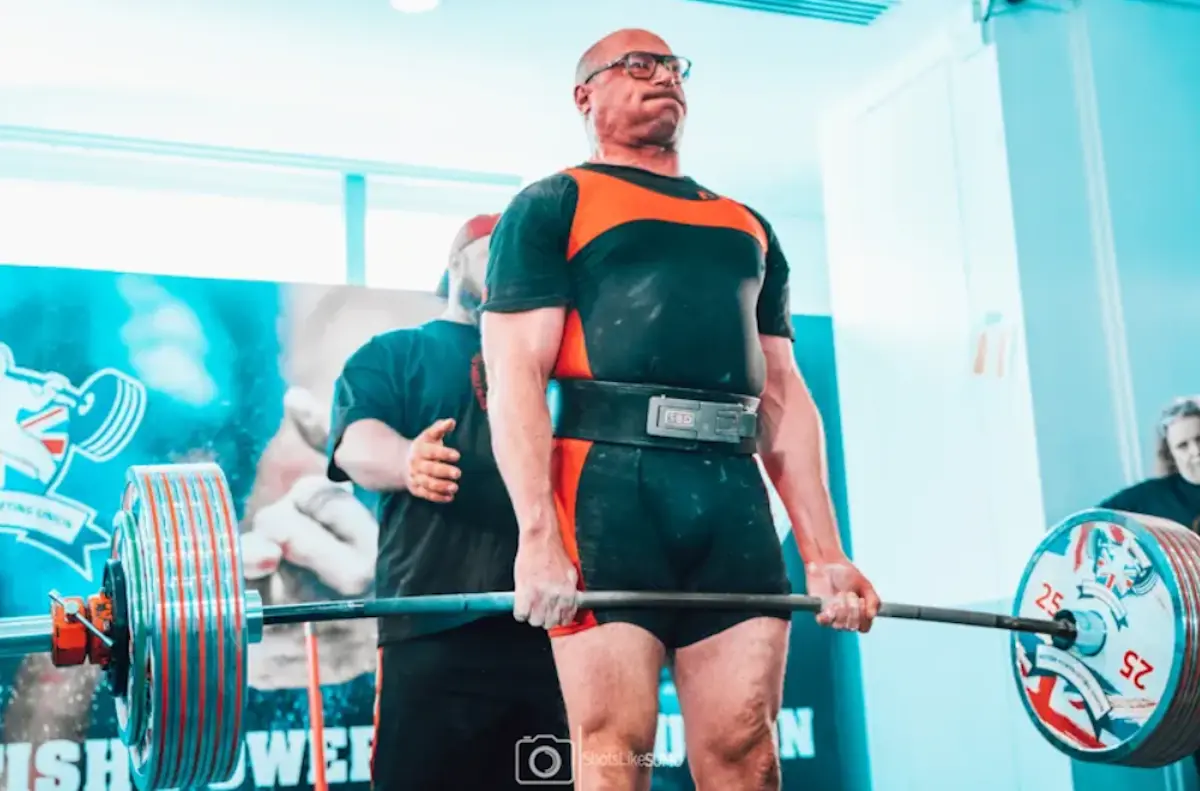
What's In This Article
- Key Highlights
- Introduction to Deadlift Variations
- Sumo Deadlift: An Overview
- Conventional Deadlift: An Overview
- Detailed Comparison: Sumo vs. Conventional Deadlifts
- Which Deadlift Variant is Harder? Pros and Cons
- Choosing the Right Deadlift for Your Needs
- Health and Safety Considerations
- Performance and Training Implications
- Final Thoughts on Sumo Deadlift vs Conventional
- Frequently Asked Questions
- References
- Resources
Key Highlights
- Sumo deadlift uses a wider stance with hands inside legs, while conventional uses a hip-width stance with hands outside.
- Sumo emphasizes quads and inner thighs, while conventional targets the posterior chain (lower back, hamstrings, glutes).
- Those with longer legs often prefer sumo, while shorter-legged lifters typically favor conventional.
- Sumo allows for a more upright torso and reduced range of motion, potentially enabling heavier lifts.
- Conventional deadlift places more stress on the lower back but may better translate to everyday lifting movements.
- Both styles are legitimate competition lifts, with neither being "cheating" - the choice depends on individual body mechanics and goals.
Introduction to Deadlift Variations
The deadlift is essential for building overall body strength in strength training. It includes variations like sumo and conventional deadlifts, each with unique stances, grips, and muscle engagement patterns. This compound exercise efficiently targets multiple muscle groups for strength and muscle mass gains.
With a wider stance and upright torso, the sumo deadlift targets the glutes, hips, and quadriceps. Ideal for individuals with longer legs and shorter arms, this variation minimizes the range of motion needed to lift the bar from the ground. It's excellent for strengthening the posterior chain, emphasizing the hip hinge.
Conventional deadlifts target the posterior chain muscles like hamstrings, lower back, and glutes. This form is preferred by lifters with shorter legs and longer arms for biomechanical advantage.
The choice between sumo and conventional deadlifts often hinges on individual body mechanics and leverages, personal preferences, and specific training goals.
Matt Wenning, a world-class powerlifting coach and lower of Wenning Strength, emphasizes the benefits of training in both styles. He recommends incorporating sumo deadlifts for form and speed work, even when primarily training conventional, as it can improve hip flexibility and transfer positively to conventional deadlifts.
Sumo Deadlift: An Overview
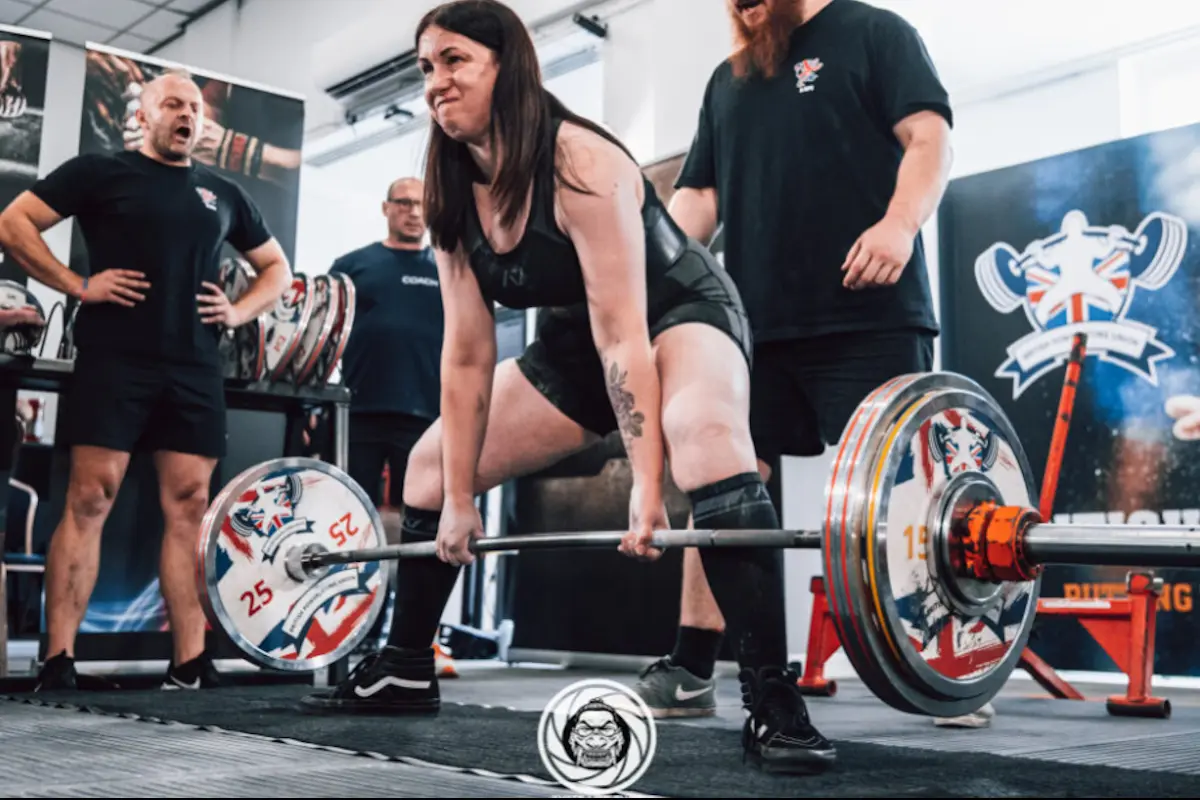
The sumo deadlift, a variant of the traditional barbell dl, is distinguished by its unique setup and execution.
- In this variation, the lifter adopts a wide stance, known as the sumo position, with feet placed significantly wider than shoulder-width apart.
- This stance resembles the position of a sumo wrestler, hence the name.
- The arms are positioned inside the knees, allowing a vertical torso and a more direct upward pull.
- This positioning puts less stress on the lumbar spine while engaging the muscles of the hips and legs more.
- The sumo deadlift works by leveraging the body's mechanics, which is particularly beneficial for those with a shorter arm span and longer legs.
- 2019 research by Cholewa et al. investigated the relationship between anthropometrics and sumo vs. conventional deadlift performance, suggesting that individuals with longer torsos may have a slight mechanical advantage in the sumo deadlift.
Mastering this technique requires considerable practice to ensure the knees remain aligned with the toes throughout the entire lift and to avoid rounding the back.
Conventional Deadlift: An Overview
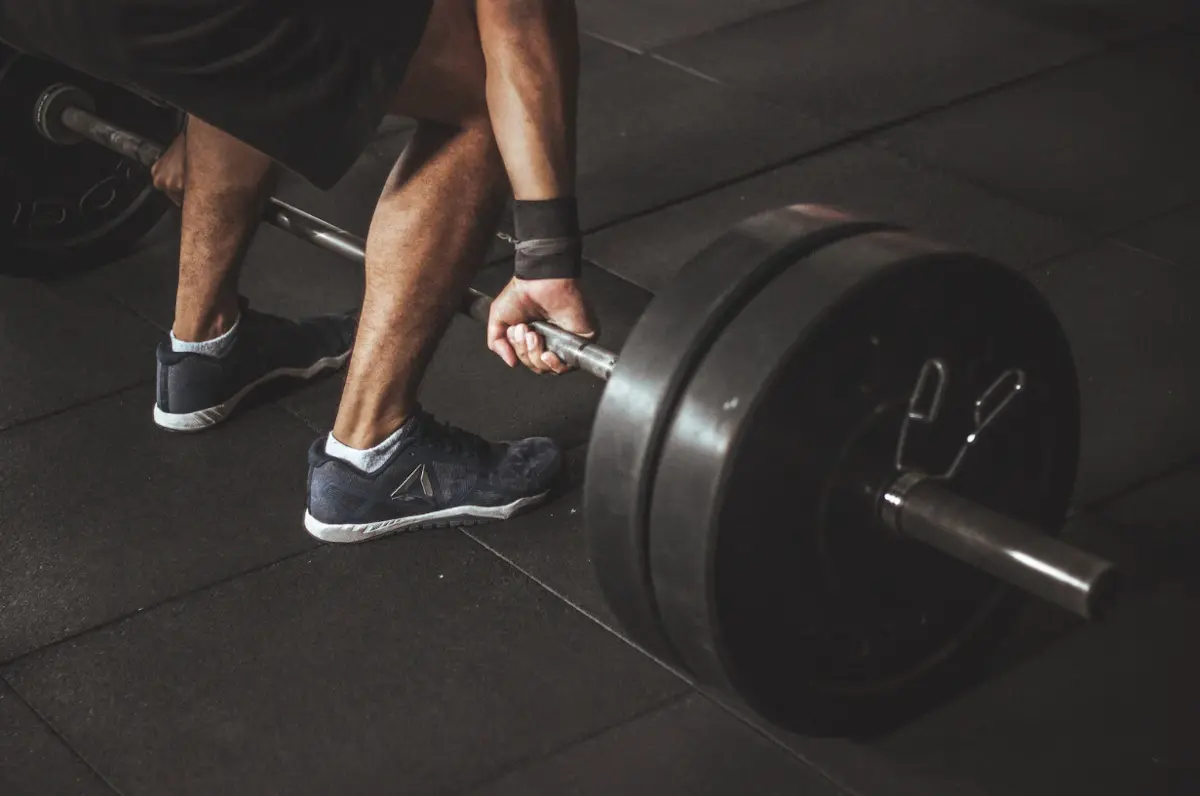
The conventional deadlift is a fundamental weightlifting exercise that engages the entire body, particularly the posterior chain.
- This variant involves a narrow stance, with feet about hip-width apart.
- The hands grasp the barbell outside the legs, creating a biomechanical dynamic different from the sumo stance.
- In executing the conventional deadlift, the lifter bends at the hips and knees, keeping the spine straight and the shoulder blades retracted.
- This form ensures a safe and effective lift, engaging the lower back muscles, hamstrings, and glutes.
- The movement pattern involves pushing the hips forward while pulling the weight up, maintaining the bar close to the body for the most efficient path.
This variation is often more challenging for individuals with longer legs, short arms, and shorter torso due to the increased demand for lower back strength and flexibility. However, it remains a staple in powerlifting competitions and is widely regarded as a benchmark for overall strength.
Detailed Comparison: Sumo vs. Conventional Deadlifts
Muscles Targeted in Each Style
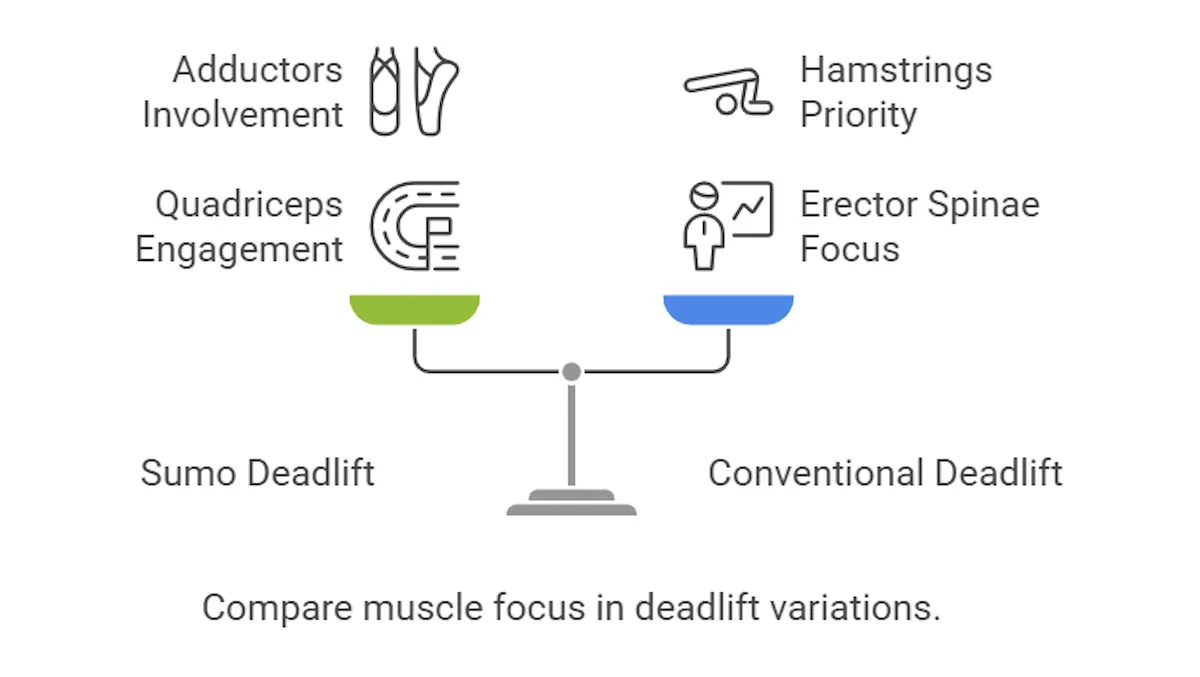
In the sumo deadlift, the primary muscles engaged are:
- Quadriceps
- Glutes
- Adductors
- To a lesser extent, the hamstrings and lower back.
The wide stance and upright torso shift the burden significantly towards the lower body, particularly the inner thighs and hips, specifically targeting the vastus medialis, vastus lateralis, and tibialis anterior (the quads and shin muscles). (Escamilla et al., 2002).
The conventional deadlift emphasizes the posterior chain, including:
- The erector spinae (muscles along the spine)
- Hamstrings
The torso's narrower stance and forward lean necessitate a robust lower back engagement, making it a powerful exercise for developing back and hamstring strength. (Martin-Fuentes et al., 2020)
Both Variations
- The level of muscle activation varies throughout the range of motion. For instance, quadriceps, tibialis anterior, and erector spinae activity are significantly greater in higher knee flexion intervals. Conversely, hamstrings and gastrocnemius activity are often greater in lower knee flexion intervals as you approach lockout. (Marques Moreira et al., 2023).
- Both variations engage the core muscles to stabilise the spine, with the conventional deadlift requiring a higher degree of lumbar spine stabilisation due to the increased torso lean.
Technique and Form
Sumo Variation
- Wide stance with toes pointed out.
- Hands grip inside knees.
- Keep knees tracking toes, chest up, minimal torso lean, engaged core
- Drive through heels and extend hips/knees together.
Conventional Variation
- Hip-width stance with hands outside legs.
- Bar stays close to the body
- Hips/shoulders rise together.
- Maintain a straight spine, retracted shoulder blades, and engaged core.
Which Deadlift Variant is Harder? Pros and Cons
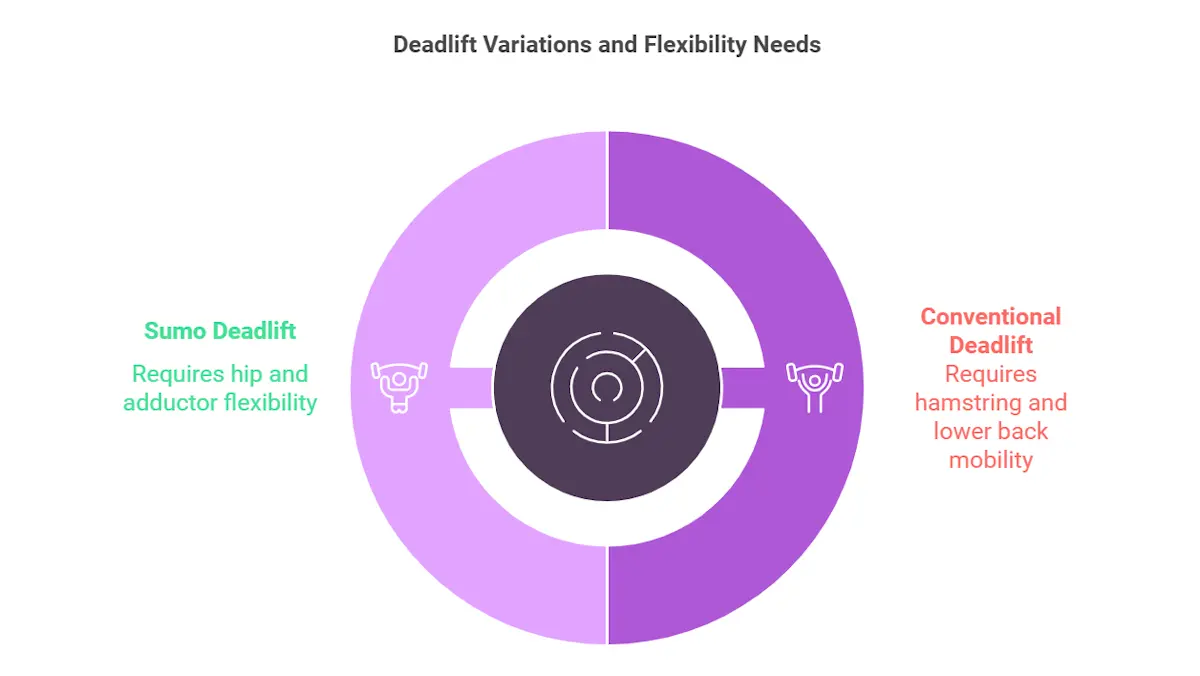
The difficulty of sumo vs conventional deadlifts often depends on the individual's body mechanics and strength areas.
Body Mechanics
- Conventional favors long arms, short legs
- Sumo benefits short arms, long legs
Muscle Focus
- Conventional: Greater back recruitment, better for Olympic lifts
- Sumo: More leg-dominant, less back strain
Flexibility Requirements
- Conventional: Demands hamstring/lower back mobility
- Sumo: Requires hip and adductor flexibility
Range of Motion
- Greg Nuckols, a strength coach and researcher, points out that sumo deadlifts have a 20-25% shorter range of motion than conventional deadlifts. However, he emphasizes that this difference in range of motion doesn't significantly impact overall performance.
Key Takeaway: Neither style is universally harder. Choose based on your anatomy, flexibility, and training goals.
Safety
- Regarding safety, the conventional deadlift has been associated with a higher risk of lower back injuries, primarily due to the increased shear forces on the lumbar spine (Cholewicki et al., 1991).
- In contrast, with its more upright posture, the sumo deadlift may reduce these forces, offering a safer alternative for individuals with pre-existing back concerns.
However, it's crucial to note that the incidence of injury in both deadlift styles can be significantly mitigated through proper technique, appropriate load management, and individualised training adaptations.
Choosing the Right Deadlift for Your Needs
Incorporating deadlifts into a strength training regimen necessitates an informed decision about whether to focus on sumo or conventional deadlifts. This choice should be predicated on individual physical characteristics, specific training objectives, and overall health considerations.
Tony Gentilcore, a respected strength coach, emphasizes the importance of individual factors when choosing between sumo and conventional deadlifts. He suggests that the key determining factor is often hip structure, which can't be determined by simple arm and leg measurements.
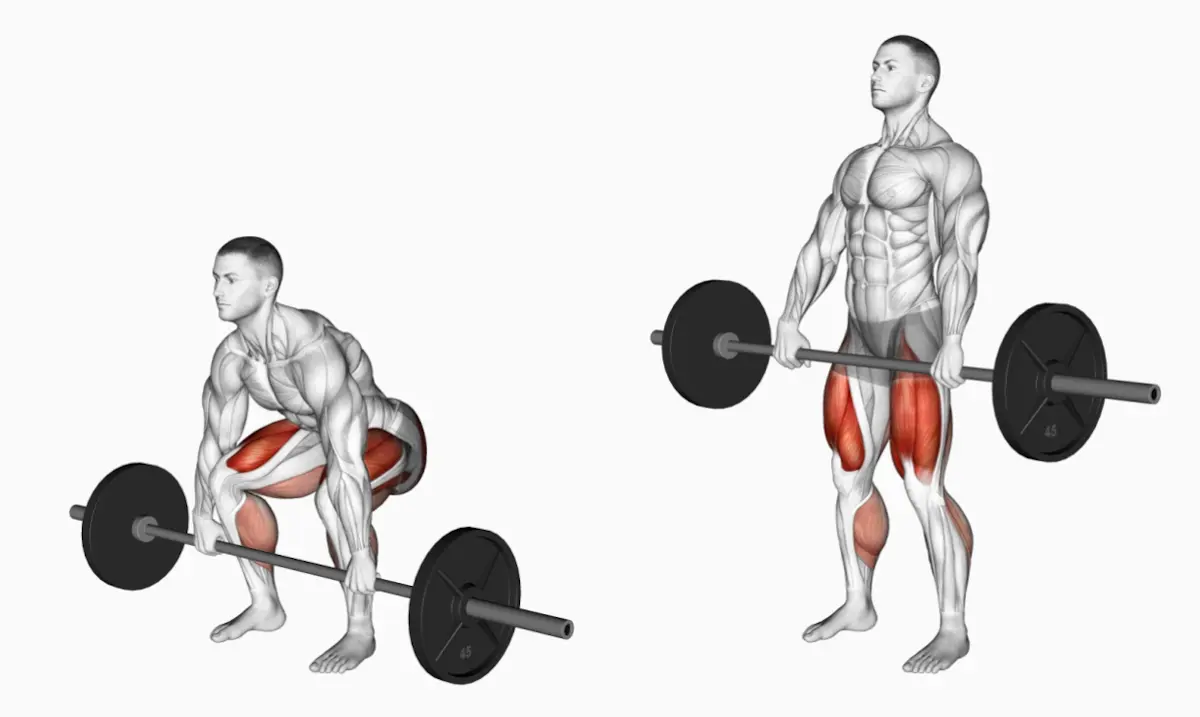
When to Opt for Conventional Deadlifts
Conventional deadlifts are particularly beneficial under certain conditions and for specific training goals:
- They are ideally suited for individuals with a body type characterised by relatively shorter legs and long arms and torsos, as this anatomy favours the biomechanics of the conventional stance.
- Additionally, those with good hamstring and lower back strength may find this style more natural and less strenuous.
- Athletes and lifters looking to enhance their overall posterior chain strength — targeting muscles like the erector spinae, hamstrings, and glutes — will find the conventional deadlift especially compelling.
- It's also a preferred choice for those seeking to improve functional strength due to its close mimicry of everyday lifting motions.
- However, individuals with a history of lower back issues should approach the conventional deadlift cautiously, given this variant's increased lumbar spine load.
- Mark Rippetoe, founder of Starting Strength, advocates for the conventional deadlift as the primary strength-building variation. He argues that conventional deadlifts use more muscle mass and are better for overall strength development.
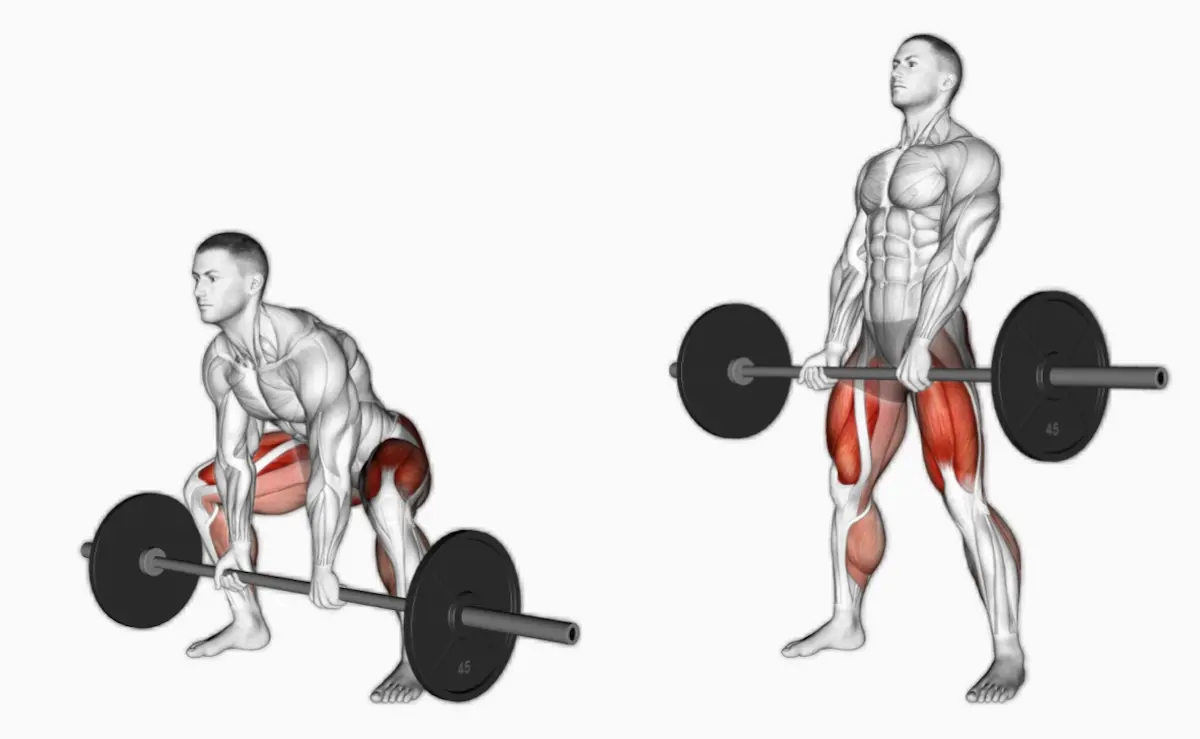
When Sumo Deadlifts are the Better Choice
With their wider stance and reduced range of motion:
- Sumo deadlifts are often more suitable for lifters with longer legs and shorter arms.
- This configuration allows for a more upright torso during the lift, significantly reducing the strain on the low back and making it a safer option for those with pre-existing back concerns.
- If you have chronic pain or an injury, it is recommended to consult with a doctor or physical therapist before incorporating sumo deadlifts into your workout routine.
- Additionally, sumo deadlifts are ideal for athletes looking to target the muscles of the inner thigh and hips more effectively. The wider stance necessitates greater activation of the adductors and quadriceps, differing from the conventional style's focus on the posterior chain.
- The sumo deadlift can be a strategic choice for lifters participating in powerlifting competitions, as it often allows for lifting heavier loads due to the reduced range of motion and more efficient force application. (McGuigan and Wilson, 1996).
Personalising Your Deadlift: Tips for Different Body Types and Goals
Selecting the suitable deadlift variant extends beyond general guidelines; it requires personalisation to align with an individual's unique body mechanics and fitness objectives. Here are some tips for tailoring your deadlift choice:
- Assess Your Body Type: Evaluate your limb lengths and flexibility. Lifters with longer arms may favour conventional deadlifts, while those with longer legs might lean towards sumo.
- Consider Your Strengths and Weaknesses: Conventional may be more suitable if your lower back is a strength. If hip strength is your forte, consider sumo.
- Test Both Variants: Experiment with both styles to understand which feels more natural and comfortable.
- Align with Your Goals: If your goal is to build overall back strength, go conventional. If you aim to focus on thigh and hip strength, sumo might be better.
- Consult a Professional: A strength coach can provide valuable insights and guidance based on your needs.
By thoughtfully considering these factors, lifters can decide which deadlift style to incorporate into their training, ensuring safety and effectiveness in their strength development journey.
##8##
Health and Safety Considerations
Health and safety considerations are paramount when incorporating deadlifts into a fitness regimen. Understanding how to prevent injuries and addressing common myths and concerns can help practitioners perform these exercises effectively and safely.
Preventing Injuries: Best Practices for Each Barbell Deadlift Type
Adhering to best practices is crucial for both sumo and conventional deadlifts to minimise the risk of injury.
- Proper Warm-Up: Begin with a dynamic warm-up to prepare the muscles and joints. This could include light cardio and dynamic stretches focusing on the hips, legs, and back.
- Technique and Form: Maintain a neutral spine throughout the lift. The sumo deadlift involves keeping the chest up and knees aligned with the toes. Keeping the bar close to the body is essential in the conventional deadlift, lifting with the legs and hips rather than pulling with the back.
- Gradual Progression: Increase weight gradually. Avoid lifting heavier than your current capability, which often leads to form breakdown and potential injury.
- Use of Equipment: Utilise lifting straps or a weightlifting belt judiciously, especially when handling heavier loads. These can provide additional support but should not be relied upon to compensate for poor technique.
- Regular Form Checks: Regularly assess your form through self-evaluation in a mirror or by seeking feedback from a trained professional, such as a personal trainer.
Addressing Common Myths and Concerns
- Myth: Sumo Deadlift is Cheating: There's a misconception that the sumo deadlift is easier or 'cheating' due to the wider stance. However, it's a different technique that utilises different muscles and mechanics.
- Myth: Deadlifts are Bad for Your Back: When performed with proper form, deadlifts are not inherently bad for your back. They can strengthen the back muscles and improve overall posture.
- Concern: Risk of Knee Injury: While the broader stance of the sumo deadlift may appear to put additional strain on the knees, proper alignment and technique can mitigate this risk. The knees should remain in line with the feet throughout the movement.
- Concern: Overtraining: Integrating deadlifts into a balanced workout plan is essential. Overtraining can lead to fatigue and increased injury risk, especially with high-intensity exercises like deadlifts.
##9##
Performance and Training Implications
Including deadlifts in a training program carries significant implications for muscle building, strength development, and functional athletic performance. Understanding which deadlift variant aligns best with specific fitness goals can optimise training outcomes.
Building Muscle and Strength: Which Deadlift Serves You Best?
The choice between sumo and conventional deadlifts can impact the efficiency of muscle and strength development.
- Sumo Deadlifts for Targeted Muscle Engagement: The sumo stance, with its wide legs and upright torso, places a greater emphasis on the quadriceps, glutes, and adductor muscles of the inner thigh. This makes it an excellent choice for those explicitly strengthening these areas. The upright posture of the sumo deadlift also reduces lumbar strain, allowing for greater frequency or volume in training sessions.
- Conventional Deadlifts for Overall Strength: The conventional deadlift engages a broad spectrum of muscles, focusing on the entire posterior chain — including the erector spinae, hamstrings, and glutes. This comprehensive muscle engagement makes it highly effective for building overall body strength. The conventional deadlift's similarity to everyday lifting motions also improves functional strength.
Functional Strength and Athletic Performance
- Sumo Deadlifts for Flexibility and Power: The sumo deadlift can enhance hip flexibility, which is beneficial for sports requiring lower body agility and power. The stance and lift mechanics also develop explosive strength, which is advantageous in athletic disciplines like sprinting and jumping.
- Conventional Deadlifts for Raw Power and Endurance: Due to their demanding nature on the posterior chain and core, the traditional deadlift is excellent for building raw power and endurance. This can directly translate to improved performance in activities that require sustained strength, such as rowing, cycling, or swimming.
- Cross-Training Benefits: Incorporating both deadlift styles into a training program can provide a balanced approach, targeting a more comprehensive range of muscle groups and improving overall athletic performance. Athletes can benefit from the varied muscle engagement and adaptability offered by practising both forms.
Final Thoughts on Sumo Deadlift vs Conventional
As we conclude our exploration of sumo and conventional deadlifts, it's clear that each style offers unique benefits and may be better suited to different individuals depending on their body type, strength goals, and overall fitness objectives.
By understanding the key differences between sumo and conventional deadlifts, individuals can decide which variation is the better option for them and their training goals.
- Personal Body Mechanics: Assess your body type and strength. Those with longer legs may find the sumo deadlift more comfortable. In contrast, individuals with a longer torso prefer the conventional deadlift.
- Training Goals: Consider what you aim to achieve. The conventional deadlift might be more beneficial to improve overall posterior chain strength. If you want to focus on the quadriceps and inner thighs, sumo deadlifts could be the way to go.
- Health Considerations: Attention to pre-existing conditions, especially the back and hips. Choose the variant that aligns with your health and safety needs.
- Experimentation: Try both styles to see which feels more natural. Keep an open mind, as your preference might change as you progress your training.
- Seek Professional Advice: Consult with a fitness professional or personal trainer. They can provide personalised advice based on your specific needs and help refine your technique.
- Incorporate Variety: Consider using both styles in your training regimen. This can lead to a more well-rounded strength profile and keep your workouts engaging and challenging.
Nuckols points out that no inherent factors make either the conventional or sumo deadlift easier or harder. He advises lifters to train both styles hard for a while, then stick with the strongest and most comfortable.
In essence, the choice between sumo and conventional deadlifts is not a matter of right or wrong; it's about what works best for you as an individual. By considering your physical characteristics, health, and fitness goals, you can make an informed decision that enhances your strength training journey.
Frequently Asked Questions
Is Sumo Deadlifting Cheating?
Sumo deadlifting is sometimes considered cheating in fitness circles due to its wider stance and shorter range of motion, which may seem easier than conventional deadlifting. However, this overlooks the unique biomechanical and muscular challenges the sumo deadlift poses.
Recognizing that both sumo and conventional deadlift styles are valid in powerlifting competitions is crucial. Each style offers unique benefits and challenges, with neither being superior. The decision between the two should depend on individual biomechanics, goals, and preferences rather than perceived difficulty or unfair advantage.
Can I Incorporate Both Conventional and Sumo Deadlifts in My Routine?
Incorporating conventional and sumo deadlifts into a training routine can be highly beneficial. This approach allows athletes to reap the benefits of both exercises, targeting a more comprehensive range of muscle groups and addressing different aspects of strength and conditioning.
By alternating between different styles, lifters can develop balanced musculature, reducing the risk of overuse injuries and preventing plateauing. This variation challenges the muscles in new ways, promoting ongoing strength and muscle development.
Additionally, incorporating both deadlift styles can enhance overall lifting technique and body awareness. It allows lifters to understand and work with their body mechanics more effectively, adapting their training to suit their unique physical strengths and limitations.
How Much Weight Should I Start With for Each Style?
Start with just the barbell to master form, then gradually add weight based on your strength level and comfort - most beginners can safely progress by adding 5-10 pounds per session while maintaining proper technique.
How Do I Know if I'm Ready to Progress to Heavier Weights?
You're ready to add weight when you can complete all sets with perfect form, maintain a neutral spine throughout the movement, and feel in control of the bar - if any of these factors decline, stay at your current weight until mastered.
How Long Should I Rest Between Deadlift Sets?
Rest 3-5 minutes between heavy sets to allow full ATP replenishment and maintain proper form, though beginners can start with 2-3 minutes between lighter sets.
References
- Cholewa, J. M., Atalag, O., Zinchenko, A., Johnson, K., & Henselmans, M. (2019). Anthropometrical determinants of deadlift variant performance. Journal of Sports Science and Medicine, 18(3), 448-453.
- Cholewicki, J., McGill, S. M., & Norman, R. W. (1991). Lumbar spine loads during the lifting of extremely heavy weights. Medicine & Science in Sports & Exercise, 23(10), 1179-1186.
- Escamilla, R. F., Francisco, A. C., Kayes, A. V., Speer, K. P., & Moorman, C. T. (2002). An electromyographic analysis of sumo and conventional style deadlifts. Medicine & Science in Sports & Exercise, 34(4), 682-688.
- Martín-Fuentes, I., Oliva-Lozano, J. M., & Muyor, J. M. (2020). Electromyographic activity in deadlift exercise and its variants: A systematic review. PLoS One, 15(2), e0229507.
- McGuigan, M. R., & Wilson, B. D. (1996). Biomechanical analysis of the deadlift. The Journal of Strength & Conditioning Research, 10(4), 250-255.
- Moreira, V. M., de Lima, L. C. R., Mortatti, A. L., de Souza, T. M. F., Lima, F. V., Oliveira, S. F. M., ... & Banja, T. (2023). Analysis of muscle strength and electromyographic activity during different deadlift positions. Muscles, 2(2), 218-227.
Resources
- Sumo Deadlift Form: Learn How To Perfect The Movement - Eric Roberts Fitness
- 7-Step Guide to Learning the Sumo Deadlift - Elite FTS
- The Ultimate Guide to Proper Deadlift Technique - Muscle & Motion
- How to Deadlift with Proper Form: The Definitive Guide - StrongLifts
- Sumo vs Conventional Deadlift: Which Is Better? - Eric Roberts Fitness